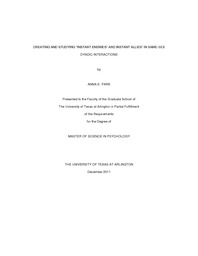| dc.description.abstract | The present study was designed to investigate the “instant enemy” and “instant ally” phenomena. Forty-three pairs of unacquainted college students interacted in same-sex and same-race pairs for 10 minutes. In the enemy condition, the dyads consisted of one participant who was liberal and one participant who was conservative. In the ally condition, both participants were either liberal or both participants were conservative. It was expected that dyads consisting of political opposites would behave like “instant enemies,” whereas dyads consisting of participants with similar political attitudes would behave more like “instant allies.” This general prediction was expected to be reflected in self-report, behavioral measures, and physiological measures of stress (e.g., cortisol). The results failed to support any of the formal hypotheses. However, some effects that were not formally hypothesized were found. For instance, preliminary evidence was found that suggested that the strangers' interactions were negative when the participants had dissimilar attitudes and at least one participant was low on agreeableness. | en_US |

